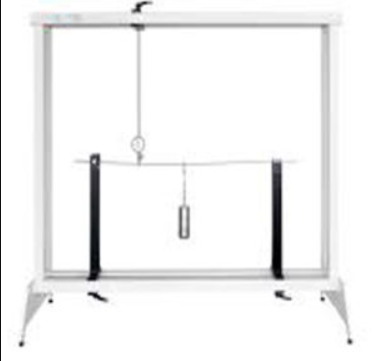Elastic Line Of A Beam
Categories: Engineering Lab EquipmentBeams are important design elements in mechanical engineering and building construction that can deform under load. Beams are subjected to load transversely in the axial direction, which leads to defl...
Product
Description
Beams are important design
elements in mechanical engineering and building construction that can deform
under load. Beams are subjected to load transversely in the axial direction,
which leads to deflection. In linear–elastic material behaviour, the bending
line, also known as elastic line, is used to determine the deflection of beams.
Deflection can be determined at any point on the beam using the influence
coefficients and Maxwell–Betti’s commutative theory.
The unit is used to determine the
deformation of a bending beam. To do this, a beam is studied under varying
loads, different support conditions and static overdetermination. The elastic
line is determined by calculation and verified by experiment.
Learning Objectives/Experiments:
Elastic line under varying load
Elastic line under various support
conditions
Demonstration of Maxwell–Betti’s
theorem
Elastic line and support forces in
statically indeterminate systems
Specification
Determine the elastic line
Beams of different materials:
steel, brass and aluminium
2 pinned supports
1 fixed support with clamp
Dial gauges for recording the
deformation of the beam
Storage system for parts
Experiment setup in the mounting
frame
Technical Data
Beams
steel, LxWxH: 1000x20x3mm
brass, LxWxH: 1000x20x6mm
aluminium, LxWxH: 1000x20x6mm
Weights
2x 1N (hanger)
10x 1N
6x 5N
Measuring ranges
travel: 0…20mm
graduation: 0,01mm
quick overview :
Beams are important design
elements in mechanical engineering and building construction that can deform
under load. Beams are subjected to load transversely in the axial direction,
which leads to deflection. In linear–elastic material behaviour, the bending
line, also known as elastic line, is used to determine the deflection of beams.
Deflection can be determined at any point on the beam using the influence
coefficients and Maxwell–Betti’s commutative theory.
The unit is used to determine the
deformation of a bending beam. To do this, a beam is studied under varying
loads, different support conditions and static overdetermination. The elastic
line is determined by calculation and verified by experiment.
Learning Objectives/Experiments:
Elastic line under varying load
Elastic line under various support
conditions
Demonstration of Maxwell–Betti’s
theorem
Elastic line and support forces in
statically indeterminate systems
Specification
Determine the elastic line
Beams of different materials:
steel, brass and aluminium
2 pinned supports
1 fixed support with clamp
Dial gauges for recording the
deformation of the beam
Storage system for parts
Experiment setup in the mounting
frame
Technical Data
Beams
steel, LxWxH: 1000x20x3mm
brass, LxWxH: 1000x20x6mm
aluminium, LxWxH: 1000x20x6mm
Weights
2x 1N (hanger)
10x 1N
6x 5N
Measuring ranges
travel: 0…20mm
graduation: 0,01mm
Product
Reviews
add Review
reviews
No Review Yet.
Copyrights © 2025 All Rights Reserved by Atico














Product
Reviews
add Review
reviews
No Review Yet.